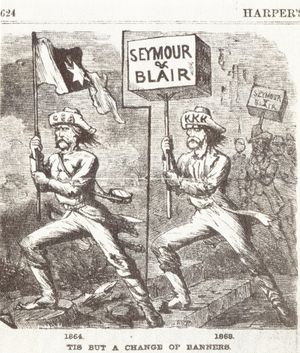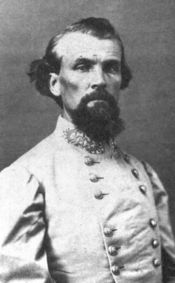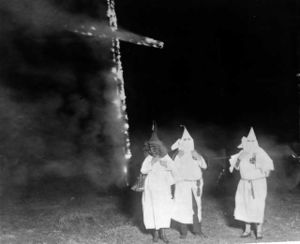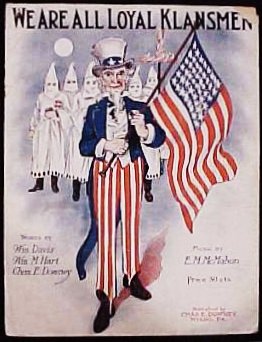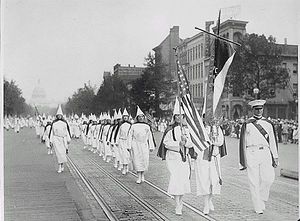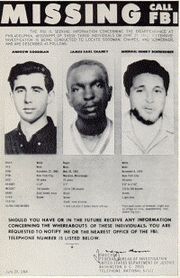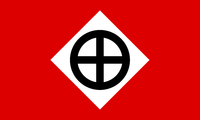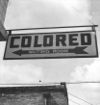كو كلوكس كلان
 شعار كلو كلوكس كلان | |
| في الوجود | |
|---|---|
| الكلان الأول | 1865–عقد 1870 |
| الكلان الثاني | 1915–1944 |
| الكلان الثالث | 1946–الآن |
| الأعضاء | |
| الكلان الأول | غير معروف |
| الكلان الثاني | 3,000,000–6,000,000[1] (peaked in 1924–25) |
| الكلان الثالث | 5,000–8,000[2] |
| الخصائص | |
| الأيديولوجيا السياسية | تفوق البيض قومية البيض العداء للمهاجرين[3] معاداة الهجرة معاداة الشيوعية الإرهاب المسيحي[4][5] معاداة الكاثوليكية معاداة السامية رهاب المثلية الفاشية الجديدة (الكلان الثالث) |
| الديانة | الپروتستانتية |
كو كلوكس كلان إنگليزية: Ku Klux Klan واختصارا تدعى أيضا KKK، هو اسم يطلق على عدد من المنظمات الأخوية في الولايات المتحدة الأمريكية منها القديم ومنها من لا يزال يعمل حتى اليوم. تؤمن هذه المنظمات بالتفوق الأبيض ومعاداة السامية والعنصرية ومعاداة الكاثوليكية، كراهية المثلية وأخيرا بالأهلانية. تعمد هذه المنظمات عموما لاستخدام العنف والإرهاب وممارسات تعذيبية كالحرق على الصليب لاضطهاد من يكرهونهم مثل الأمريكيين الأفارقة وغيرهم.
نظرة عامة: الكلان الثلاثة
الكلان الأول
أول ظهور أو تشكل للكلان كان في عام 1866. حيث تأسست من قبل المحاربين القدامي في الجيش الكونفدرالي وكانت مهمة هذه المنظمة مقاومة إعاد التأسيس ومعارضة تحرير العبيد التي حدثت عقب الحرب الأهلية الأمريكية. سرعان ما طورت هذه المنظمة أساليب عمل عنيفة. عندئذ كانت ممارسات الكلان عذرا لحلفاء الجنوبيين لمتابعة القوات الفيدرالية فعالياتها في الجنوب. انحسرت منظمة الكلان بين عامي 1868 و1870 وتم تدميرها بالكامل في بدايات السبعينات من القرن التاسع عشر على يد الرئيس أوليسيس گرانت Ulysses S. Grant في عملية الحقوق المدنية لعام 1871 (تعرف أيضا بعملية كو كلوكس كلان).
الكلان الثاني
الظهور الثاني كان في عام 1915 عن طريق جماعة تبنت نفس الاسم متأثرة بقوة افعال الجديدة لفيلم حمل اسم ميلاد أمة The Birth of a Nation إضافة لكتابات صحفية معادية للسامية أحاطت بمحاكمة المجرم ليو فرانك. كانت الجماعة الثانية من (ك.ك.ك) منظمة رسمية تتألف من عضوية رسمية ذات بنية قومية، مما دفع الكثير من الرجال لتأسيس فروع محلية في كافة أرجاء الولايات المتحدة. بلغت هذه المنظمة الذروة في العشرينات من القرن العشرين حيث ضمت حوالي 15% من التعداد الرسمي للسكان في الولايات المتحدة. [6]
كانت المنظمة الثانية للكلان تعتنق أفكارا عنصرية ومعادية للسامية ومعادية للكاثوليكية إضافة للشعور القومي ومعظم هذه الجماعات قامت باعمال تندرج ضمن العقاب اللينشي lynching (الاعدام بالشنق ودون محاكمة) وغيرها من العمال العنيفة. شعبية هذه الحركة انخفضت بشكل كبير خلال فترة الكساد الكبير Great Depression ثم انخفضت أعداد العضاء أكثر خلال الحرب العالمية الثانية نتيجة فضائح نتجت عن جرائم الأقادة البارزين ودعمهم للنازيين.
الكلان الثالث
الكلان الأول: 1865–1871
التأسيس والتسمية
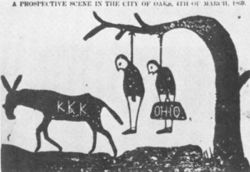
الأنشطة

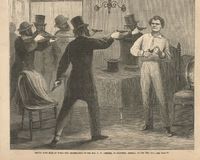
المقاومة
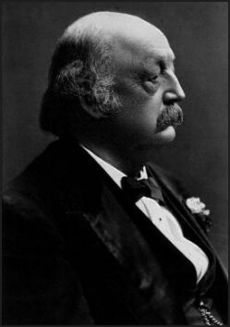
نهاية الكلان الأول
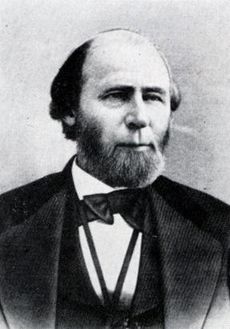
الكلان الثاني: 1915–1944
اعادة التأسيس عام 1915
ميلاد الأمة
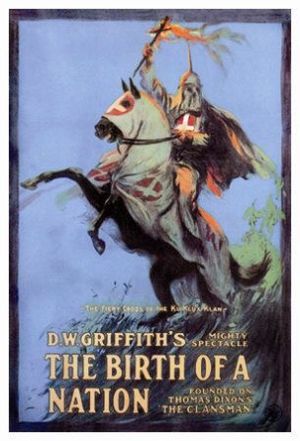
الأهداف

التنظيم
التهديدات الأخلاقية
النمو السريع
الحظر
التحديث
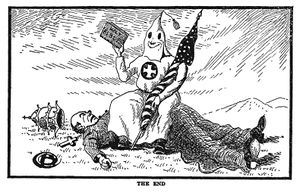
الأزياء وحرق الصليب
المرأة
الدور السياسي
المقاومة والأفول

العمل ومكافحة العمل النقابي
تأريخ الكلان الثاني
المقاومة
الكلان المعاصر: عقد 1970 –الآن

اسم "كلو كلوكس كلان" "Ku Klux Klan" استخدم منذ ذلك وبعد تفتيت الظهور الثاني لهم للأشاره للعديد من المنظمات العنصرية المختلفة واللامترابطة، بما فيهم من يعارض قانون الحقوق المدنية Civil Rights Act وإنهاء العنصرية desegregation في الخمسينات والستينات. بعضهم كان يرتكب جرائم بحق نشطاء الحقوق المدنية والأطفال. وقام متطرفون منتسبون لها بتفجير الكنيسة المعمدانية في شارع 16 في 15 سبتمبر 1963 في مدينة بيرمنجهام في ولاية ألاباما في أميركا.
وقد تراجعت كثيرا شعبيتهم في الاونه الأخيرة الجدول التالي يوضح أرقام اعضاء الكو كلوكس كلان خلال القرن الماضي بالأخذ بعين الاعتبار ان السنوات والارقام تقريبية [8]
| السنة | العضوية | |
|---|---|---|
| 1920 | 4,000,000 | [9] |
| 1924 | 6,000,000 | |
| 1930 | 30,000 | |
مذبحة محتجي حزب العمال الشيوعيين
تسلل جيري ثومپسون
إطلاق النار في تنسي
الإعدام الغير قانوني لمايكل دونالد
تحالفات النازية الجديدة وستورمفرونت
التطورات الحالية
التنظيمات الحالية لكلان
بلدان أخرى
الألقاب والمفردات
انظر أيضاً
- Anti-mask laws
- Black Legion (political movement)
- History of the Ku Klux Klan in New Jersey
- Ku Klux Klan in Canada
- Ku Klux Klan in Inglewood, California
- Ku Klux Klan in Maine
- Ku Klux Klan members in United States politics
- Ku Klux Klan recruitment
- Ku Klux Klan regalia and insignia
- Leaders of the Ku Klux Klan
- List of Ku Klux Klan organizations
- List of organizations designated by the Southern Poverty Law Center as hate groups
- List of white nationalist organizations
- إرهاب عرقي
- مذبحة روزوود
- White Knights of the Ku Klux Klan
المصادر
- ^ McVeigh, Rory. "Structural Incentives for Conservative Mobilization: Power Devaluation and the Rise of the Ku Klux Klan, 1915–1925". Social Forces, Vol. 77, No. 4 (June 1999), p. 1463.
- ^ "Ku Klux Klan". Southern Poverty Law Center. Retrieved February 7, 2013.
- ^ خطأ استشهاد: وسم
<ref>غير صحيح؛ لا نص تم توفيره للمراجع المسماةpegram - ^ Al-Khattar, Aref M. (2003). Religion and terrorism: an interfaith perspective. Westport, CT: Praeger. pp. 21, 30, 55.
- ^ Michael, Robert, and Philip Rosen. Dictionary of antisemitism from the earliest times to the present. Lanham, Maryland, USA: Scarecrow Press, 1997, p. 267.
- ^ According to the 1920 census, the population of white males 18 years and older was about 31 million, but many of these men would have been ineligible for membership because they were immigrants, Jews, or Roman Catholics. Klan membership peaked at about 4-5 million: http://www.aaregistry.com/african_american_history/2207/The_Ku_Klux_Klan_a_brief__biography, retrieved August 26, 2005.
- ^ "History of the Ku Klux Klan - Preach the Cross". preachthecross.net. Retrieved 15 September 2014.
- ^ . The 20th Century Ku Klux Klan in AlabamaThe Ku Klux Klan, a brief biography!, History of the Ku Klux Klan, What is the KKK?, Ku Klux Klan in the Twentieth Century, all retrieved August 26, 2005.
- ^ "The Various Shady Lives of The Ku Klux Klan". Time. April 9, 1965. Retrieved December 24, 2009.
مراجع
- Axelrod, Alan (1997). The International Encyclopedia of Secret Societies & Fraternal Orders. New York: Facts On File.
- Baker, Kelly J. Gospel According to the Klan: The KKK's Appeal to Protestant America, 1915-1930 (University Press of Kansas, 2011) ISBN 978-0700617920.
- Barr, Andrew (1999). Drink: A Social History of America. New York: Carroll & Graf.
- Chalmers, David M. (1987). Hooded Americanism: The History of the Ku Klux Klan. Durahm, N.C.: Duke University Press. p. 512. ISBN 978-0-8223-0730-3.
- Chalmers, David M. (2003). Backfire: How the Ku Klux Klan Helped the Civil Rights Movement. ISBN 0-7425-2310-1.
- Cunningham, David. Klansville, USA: The Rise and Fall of the Civil Rights-Era Ku Klux Klan (Oxford University Press, 2013). 360pp.
- Dray, Philip (2002). At the Hands of Persons Unknown: The Lynching of Black America. New York: Random House.
- Egerton, John (1994). Speak Now Against the Day: The Generation Before the Civil Rights Movement in the South. Alfred and Knopf Inc.
- Feldman, Glenn (1999). Politics, Society, and the Klan in Alabama, 1915–1949. Tuscaloosa, Alabama: University of Alabama Press.
- Fleming, Walter J. Ku Klux Klan: Its Origins, Growth and Disbandment (1905)
- Foner, Eric (1989). Reconstruction: America's Unfinished Revolution, 1863–1877. Perennial (HarperCollins).
- Fox, Craig. Everyday Klansfolk: White Protestant Life and the KKK in 1920s Michigan (Michigan State University Press, 2011), 274 pp. ISBN 978-0-87013-995-6.
- Franklin, John Hope (1992). Race and History: Selected Essays 1938–1988. Louisiana State University Press.
- Fryer, Roland G., Jr; Levitt, Steven D. (September 2007), Hatred and Profits: Getting Under the Hood of the Ku Klux Klan, National Bureau of Economic Research, http://www.nber.org/papers/w13417, retrieved on 22 January 2015
- Horn, Stanley F. (1939). Invisible Empire: The Story of the Ku Klux Klan, 1866–1871. Montclair, New Jersey: Patterson Smith Publishing Corporation.
- Ingalls, Robert P. (1979). Hoods: The Story of the Ku Klux Klan. New York: G.P. Putnam's Sons.
- Jackson, Kenneth T. (1967). The Ku Klux Klan in the City, 1915–1930 (1992 ed.). New York: Oxford University Press.
- Kennedy, Stetson (1990). The Klan Unmasked. University Press of Florida.
- Lay, Shawn (1995). Hooded Knights on the Niagara: The Ku Klux Klan in Buffalo, New York. New York and London: New York University Press. ISBN 9780814751015. Retrieved 6 December 2015.
- McVeigh, Rory. The Rise of the Ku Klux Klan: Right-Wing Movements and National Politics (2009), on 1920s.
- Lender, Mark E.; Martin, James K. (1982). Drinking in America. New York: Free Press.
- Lewis, George. ""An Amorphous Code": The Ku Klux Klan and Un-Americanism, 1915–1965." Journal of American Studies (2013) 47#4 pp: 971-992.
- McWhorter, Diane (2001). Carry Me Home: Birmingham, Alabama, The Climactic Battle of the Civil Rights Revolution. New York: Simon & Schuster.
- Moore, Leonard J. (1991). Citizen Klansmen: The Ku Klux Klan in Indiana, 1921–1928. Chapel Hill: University of North Carolina Press.
- Newton, Michael; Newton, Judy Ann (1991). The Ku Klux Klan: An Encyclopedia. New York & London: Garland Publishing.
- Parsons, Elaine Frantz (2005). "Midnight Rangers: Costume and Performance in the Reconstruction-Era Ku Klux Klan". The Journal of American History. 92 (3): 811–836. doi:10.2307/3659969.
- Pegram, Thomas R. One hundred percent American: the rebirth and decline of the Ku Klux Klan in the 1920s (Rowman & Littlefield, 2011)
- Pitsula, James M. Keeping Canada British: The Ku Klux Klan in 1920s Saskatchewan (University of British Columbia Press, 2013)
- Prendergast, Michael L. (1987). "A History of Alcohol Problem Prevention Efforts in the United States". In Holder, Harold D. (ed.). Control Issues in Alcohol Abuse Prevention: Strategies for States and Communities. Greenwich, Connecticut: JAI Press.
- Rhodes, James Ford (1920). History of the United States from the Compromise of 1850 to the McKinley-Bryan Campaign of 1896. Vol. 7. Winner of the 1918 Pulitzer Prize for history.
- Rogers, William; Ward, Robert; Atkins, Leah; Flynt, Wayne (1994). Alabama: The History of a Deep South State. Tuscaloosa, Alabama: University of Alabama Press.
- Steinberg, Alfred (1962). The man from Missouri; the life and times of Harry S. Truman. New York: Putnam. OCLC 466366.
- Taylor, Joe G. (1974). Louisiana Reconstructed, 1863–1877. Baton Rouge.
{{cite book}}: CS1 maint: location missing publisher (link) - Thompson, Jerry (1982). My Life in the Klan. New York: Putnam. ISBN 0-399-12695-3.
- Trelease, Allen W. (1995). White Terror: The Ku Klux Klan Conspiracy and Southern Reconstruction. Louisiana State University Press.
- Wade, Wyn Craig. The Fiery Cross: The Ku Klux Klan in America (Oxford University Press, 1998)
تأريخ
- Eagles, Charles W. "Urban‐Rural Conflict in the 1920s: A Historiographical Assessment." Historian (1986) 49#1 pp: 26-48.
- Horowitz, David A. "The Normality of Extremism: The Ku Klux Klan Revisited." Society (1998) 35#6 pp: 71-77.
- Lay, Shawn, ed. The invisible empire in the west: Toward a new historical appraisal of the Ku Klux Klan of the 1920s (2nd ed. University of Illinois Press, 2004)
- Lewis, Michael, and Jacqueline Serbu. "Kommemorating the Ku Klux Klan." Sociological Quarterly (1999) 40#1: 139-158. Deals with the memory of the KKK in Pulaski, Tennessee. Online
- Moore, Leonard J. "Historical Interpretations of the 1920's Klan: The Traditional View and the Populist Revision" Journal of Social History (1990) 24#2 pp 341–357. in JSTOR
- Sneed, Edgar P. "A Historiography of Reconstruction in Texas: Some Myths and Problems." Southwestern Historical Quarterly (1969): 435-448. in JSTOR
قراءات إضافية
- Blee, Kathleen M. (1992). Women of the Klan. University of California Press. ISBN 0-520-07876-4.
- Brooks, Michael E. The Ku Klux Klan in Wood County, Ohio. Charleston: The History Press, 2014. ISBN 978-1626193345.
- Cunningham, David. Klansville, USA: The Rise and Fall of the Civil Rights-Era Ku Klux Klan. New York: Oxford University Press, 2013.
- "White supremacist groups flourishing". Gainesville Press. Associated Press. February 6, 2007.
- Nelson, Jack (1993). Terror in the Night: The Klan's Campaign Against the Jews. New York: Simon & Schuster. ISBN 0-671-69223-2.
- Chalmers, David M. (2003). Backfire: how the Ku Klux Klan helped the civil rights movement. Rowman & Littlefield. ISBN 0-7425-2310-1.
وصلات خارجية
- Prescript of the * * first edition of the Klans 1867 prescript
- Revised and Amended Prescript of the Order of the * * * first edition of the Klans 1868 prescript
- Civil Rights Greensboro
- The Ku Klux Klan in Washington State, from the Seattle Civil Rights and Labor History Project, examines the influence of the second KKK in the State during the 1920s.
- Buffalo Ku Klux Klan Membership List, digitized by the Buffalo History Museum
- "Ku Klux Klan", Southern Poverty Law Center
- "KKK", Anti-Defamation League
- "Inside Today's KKK", multimedia, Life magazine, April 13, 2009
- Interview with Stanley F. Horn, author of Invisible Empire: The Story of the Ku Klux Klan, 1866–1871 (1939), Forest History Society, Inc., May 1978
- Booknotes interview with Jack Nelson on Terror in the Night: The Klan's Campaign Against the Jews, February 7, 1993
- Articles containing إنگليزية-language text
- Pages using Lang-xx templates
- Articles with hatnote templates targeting a nonexistent page
- Pages with empty portal template
- Pages using div col with unknown parameters
- CS1 maint: location missing publisher
- تأسيسات 1865 في تنسي
- تأسيسات 1915 في الولايات المتحدة
- التاريخ الأفريقي الأمريكي
- عرقية معادية للسود
- منظمات معادية للكاثوليكية
- معادات السامية في الولايات المتحدة
- إرهاب مسيحي في الولايات المتحدة
- Clandestine groups
- عصابات في الولايات المتحدة
- جرائم كراهية
- History of racial segregation in the United States
- History of racism in the United States
- تاريخ الولايات المتحدة الجنوبية
- كو كلوكس كلان
- اعدام دون محاكمة في الولايات المتحدة
- Organizations designated as terrorist in North America
- اضطهاد اليهود
- Presidency of Ulysses S. Grant
- Racially motivated violence against African Americans
- Reconstruction Era
- Religiously motivated violence in the United States
- Right-wing populism
- White supremacist groups in the United States
- White supremacy in the United States
- History of the United States (1918–45)
- Racially motivated violence in the United States
- Anti-communist organizations in the United States
- سياسة أقصى اليمين في الولايات المتحدة
- American secret societies
- Anti-Catholicism in the United States
- Protestantism in the United States
- Protestant organizations
- الإرهاب في الولايات المتحدة
- منظمات سرية
